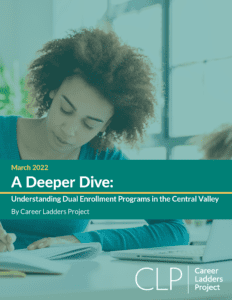 Dual enrollment, which allows a student to enroll in both high school and college at the same time, has long been acknowledged as a powerful acceleration strategy for college completion. Multiple studies have shown that students who participate in high-quality dual enrollment programs during high school are more likely to graduate high school, enter college, and persist in college to completion (Cowan & Goldhaber, 2013; Karp et al., 2007; Rodriguez, Hughes, & Belfield, 2012; Speroni, 2011; Struhl & Vargas, 2012). Dual enrollment has been shown to be a particularly effective success strategy for first-generation students, male students, students of color and low-income students, especially when part of a pathway design.
Dual enrollment, which allows a student to enroll in both high school and college at the same time, has long been acknowledged as a powerful acceleration strategy for college completion. Multiple studies have shown that students who participate in high-quality dual enrollment programs during high school are more likely to graduate high school, enter college, and persist in college to completion (Cowan & Goldhaber, 2013; Karp et al., 2007; Rodriguez, Hughes, & Belfield, 2012; Speroni, 2011; Struhl & Vargas, 2012). Dual enrollment has been shown to be a particularly effective success strategy for first-generation students, male students, students of color and low-income students, especially when part of a pathway design.
Over the last several years, California has moved to strengthen and expand dual enrollment. Although overall the number of students taking college courses while in high school has increased, there are still gaps in access among racial/ethnic groups. One bright spot is “high-school only” dual enrollment, which refers to dual enrollment offered at the high school in structured programs that provide sequenced courses with embedded supports for students. Recent research from Wheelhouse: The Center for Community College Leadership found that participation in high-school only dual enrollment had smaller racial/ethnic access gaps that decreased over time, compared with other types of dual enrollment (A Leg Up on College, 2020; A Rising Tide, 2020; and A Foot in the Door, 2021). However, Wheelhouse also found that students were constrained in accessing dual enrollment opportunities based on the high schools they attend. While some schools have active dual enrollment programs and partnerships, others have only a few.
Prepared by Career Ladders Project
March 2022